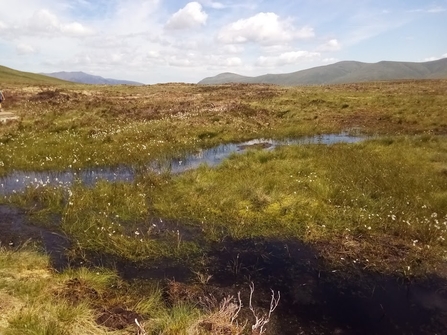
Cotton-grass flourishing at Armboth, following peatland restoration work with National Trust, United Utilities, Natural England & Defra © Cumbria Wildlife Trust
Gifting membership? Order by Wednesday 17 December in time for Christmas.

Cotton-grass flourishing at Armboth, following peatland restoration work with National Trust, United Utilities, Natural England & Defra © Cumbria Wildlife Trust
A new report published today by The Wildlife Trusts reveals that society must take fast action to adapt to the impacts of the climate crisis and be prepared to see nature and wild places change in order to survive.
The Wildlife Trusts’ first climate risk assessment, Changing Nature, examines the impacts of the changing climate across their estate, which includes our 41 nature reserves across Cumbria. It assesses the risks and looks ahead at what is needed to help nature adapt and survive in the future. The findings come at a time when the UK is already one of the most nature-depleted countries in the world.
The research finds that, by the 2050s, under a future warming trajectory that reaches 3°C warming by 2100:
The Wildlife Trusts want to see increased effort from governments, business, and other landowners on climate adaptation, including greater investment in nature-based solutions and a specific focus on resilience.
Stephen Trotter, CEO of Cumbria Wildlife Trust said:
“Climate change is contributing more and more to nature’s decline with devastating consequences for people and wildlife. We are already stepping-up our efforts to restore habitats so that they benefit wildlife and are better able to store carbon. This report also shows the range of actions Wildlife Trusts taking to help nature adapt to climate change and what’s needed in the future – from further rewetting of peatlands to backing community-led rewilding projects.
“The projected impact of climate change on our nature reserves is just the tip of the iceberg. We need people to join us in creating a new national vision for our landscapes because we can no longer focus only on restoring nature to a historical state; change is inevitable.
“A concerted effort is required to create more space for nature everywhere, enabling natural ecosystems to function properly, creating habitats for wildlife, and building diversity and flexibility for the future.”
Restoring nature at scale is the solution
Cumbria Wildlife Trust is already providing innovative solutions to help wildlife on land and sea adapt to the changing climate. Examples of projects include:
Peatlands are Cumbria’s most important store. They store five times as much carbon as all of Cumbria’s trees put together. Most peatlands are damaged and degrading, releasing carbon into the atmosphere.
We've been restoring upland peatlands since 2001. For over a year, we've been working in partnership with National Trust Riverland Project, United Utilities, Fix the Fells and Natural England to restore damaged peatlands at Armboth Fell near Keswick. Volunteers helped us plant thousands of plugs of cotton grass and heather by hand across areas of exposed peat. This species is native to peatlands and wetlands and as the plants grow their root systems will help stabilise the restored areas and reduce erosion. Repairing large areas of damaged peatlands like this will save thousands of tonnes of CO2 from being released back into the atmosphere.
More about our peatland restoration work here
The seas absorbs 20-35% of human-made CO2 emissions every year so are great carbon stores. However they have been damaged by human activity such as trawling and dredging, causing a loss of marine wildlife as well as carbon.
West of Walney, off the coast of Walney Island near Barrow, was designated as a Marine Conservation Zone in 2016. It contains sensitive mud habitats and wonderful communities of marine life, damaged after years of destructive fishing activity. We campaigned to help secure a ban on trawling within most of this site, which came into effect in 2019. This will help protect its amazing wildlife, including brittlestars, urchins, Dublin Bay prawn (also known as scampi) and delicate sea pens (left), and reduce the amount of CO2 released back into the atmosphere. We're continuing to campaign for Highly Protected Marine areas in the Irish Sea, to help our seas recover.
More about our work in the Irish Sea here
Natural Flood Management We've been working with Kendal Conservation Volunteers and the Environment Agency on a new natural flood defence project at Birds Park, to the east of Kendal. This is to help research the effectiveness of slowing the flow of floodwater from Stock Beck East down to the Sandylands estate in Kendal.
A series of willow ‘hydro-hedges’ being built in the basin of a former Kendal reservoir could hold back up to 5,000 cubic metres of water during a storm event like Storm Desmond. Once the hedges are completed, any stored water will release slowly after the flood peak, reducing the impact on properties during a storm event.
More about Birds Park project here